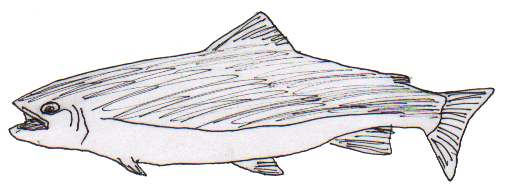 This collection of student work is from Frank Keim's classes. He wants to share these works for others to use as an example of culturally-based curriculum and documentation. These documents have been OCR-scanned and are available for educational use only.
This collection of student work is from Frank Keim's classes. He wants to share these works for others to use as an example of culturally-based curriculum and documentation. These documents have been OCR-scanned and are available for educational use only.Special | A | B | C | D | E | F | G | H | I | J | K | L | M | N | O
P | Q | R | S | T | U | V | W | X | Y | Z | ALL
King or Chinook Salmon:King or Chinook Salmon
(Oncorhynchus tshawytscha) (Taryaqvak) The King Salmon is Alaska's State fish and one of its most important sport and commercial fish. It is the largest of all Pacific salmon weighing from 30-126 pounds. In the lower 48, they call the King salmon Chinook. In British Columbia they call it Spring salmon. Other names are: quinnat, tyee, tule and black mouth. They range from the Monterey Bay area in California to the Chukchi Sea in Alaska. They also occur on the Asian coast from the Anadyr River of Siberia southeast to Hokkaido, Japan. In Alaska they occur from the southeastern panhandle to the Yukon River. The adults are distinguished by their large size and by the black irregular spotting on their back and dorsal fins and on both lobes of the caudal or tail fin. King salmon are called "black mouth" by the black pigment along the gum line. In the ocean they have a bluish green coloration on their back which fades to a silver color on both sides. They have a white belly. Fresh water colors of spawning King salmon range from red to copper to almost black. Distinguished by their "ridge back" condition and by their hooked nose or upper jaw, males are more deeply colored than females. King salmon are anadromous, which means they hatch in fresh water and they spend part of their life in the ocean. All Kings die after they spawn. They become sexually mature from the second through seventh year, and, as a result, may vary greatly in size when they spawn. Each female deposits 3,000-14,000 eggs in gravel nests, or redds, which the female excavates in relatively deep moving water. Here in Alaska the eggs hatch in late winter or early spring. Juvenile Kings first feed on plankton in fresh water. Later they eat insects. In Alaska juvenile Kings remain in fresh water until the spring when they migrate as smolt to the ocean. They eat a variety of organisms, including herring, pilchard, sand lance, squid and crustaceans. Alaska's commercial King harvest averaged about 639,000 fish in 1949. This was worth $6 million. The King salmon has an excellent market, especially in Japan, because of its large size and high oil content. Subsistence Eskimo and Indian fishermen in the Yukon and Kuskokwim Rivers catch an average of 60,000 Kings per year. The salmon is also the most highly prized sport fish in Alaska. The sport fishing harvest of King salmon is over 26,000 annually, with Cook Inlet and adjacent watersheds contributing over half of the catch. Lois Moore
| |
|




